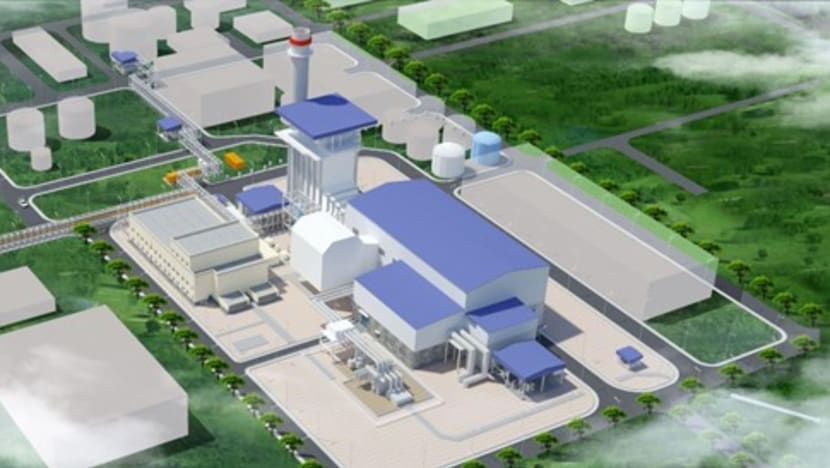Upcoming hydrogen-ready power plant will provide ‘very competitive pricing’ for consumers: YTL PowerSeraya CEO
The power station on Jurong Island will be ready by the end of 2027 and be able to power about 864,000 four-room Housing Board flats per year.

Artist's impression of an upcoming hydrogen-ready power plant on Jurong Island, to be operated by YTL PowerSeraya and completed by the end of 2027. (Photo: YTL PowerSeraya)

This audio is generated by an AI tool.
SINGAPORE: An S$800 million (US$605 million) hydrogen-ready power plant on Jurong Island will be more cost-efficient than similar facilities powered by regular turbines, said the CEO of its operator YTL PowerSeraya.
This, on top of carbon tax savings, will likely lead to savings for the public, added Mr John Ng in an interview with CNA last month.
"I believe the plant will continue to provide very, very competitive pricing in Singapore,” he said.
Work has begun on the hydrogen-ready combined cycle gas turbine, which will generate at least 600 megawatts of cleaner energy – capable of powering about 864,000 four-room Housing Board flats.
It is expected to be completed by Dec 31, 2027.
Last month, a ground-breaking ceremony was held at YTL PowerSeraya’s existing Pulau Seraya Power Station site on Jurong Island. The electricity provider won the right to develop, own and operate the new hydrogen turbine earlier this year to meet the country’s projected growth in electricity demand.
About 95 per cent of Singapore’s electricity is currently generated using imported natural gas. However, it needs to go greener to meet its national climate target of achieving net-zero emissions by 2050.
Hydrogen is a naturally occurring gas and is a clean-burning fuel, which produces no carbon dioxide when used as an energy source.
COLLABORATION CRUCIAL IN GREEN HYDROGEN
Speaking to CNA, Mr Ng stressed that the effectiveness of the new power plant will depend on cooperation among different jurisdictions – a crucial factor in building systems to support green hydrogen use.
Green hydrogen refers to hydrogen produced by the electrolysis of water, which emits only water vapour. This can significantly lower greenhouse gas emissions compared with hydrogen derived from fossil fuels.
For green hydrogen to be transported to Singapore, there must be compatible ships that can bring a big amount from one jurisdiction to another. But not many of these are available, said Mr Ng.
Infrastructure must also be in place in Singapore to receive and transport the hydrogen via pipelines to the power station, he added.
“You need the entire ecosystem to be developed to have a full value chain of the hydrogen reaching Singapore,” he pointed out.
“The entire ecosystem takes time to develop, and there are various parties very interested in developing those parts of the ecosystem."
Singapore is expected to have at least nine hydrogen-compatible power plants by 2030. The Ministry of Trade and Industry (MTI) had previously said in 2022 that hydrogen could supply up to half of Singapore's needs by 2050.
Mr Ng said that in developing these projects, it is “very important” to ensure obstacles are minimised by working with regional partners and the energy market authorities.
In the Southeast Asia power grid, for example, cooperation and collaboration across the whole region is required for electricity to be transmitted across nations, he noted.
“Some countries are better endowed with greener energy in very remote areas. Some countries have got the benefit of a very huge load that's able to take the electricity,” he said.
“So I think by leveraging the strength and opportunity that's available, we can actually move electricity from one (country) to another.”
ECONOMIC SAVINGS FOR COMPANY
When asked how cost-efficient it will be to have a hydrogen turbine rather than a regular gas turbine, Mr Ng said the Jurong Island power plant “may cost slightly higher” due to its capacity and function as a hydrogen-ready facility.
“But the efficiency you actually get out of this plant, plus the fact that it generates less carbon dioxide, will result in economic savings for the company,” he added.
“For example, if the efficiency is improved by 10 per cent, it means that your dollar per value from just pure efficiency gain can actually give you an improvement of about maybe 15 per cent thereabouts.”
Along those lines, Mr Ng said that the firm can also reduce its carbon emissions by 17 per cent on the dollar per megaton of electricity.
“With the savings in carbon tax that we have to pay, and also lesser fuel to generate the same unit of electricity, I believe there'll be savings for the general public as a whole,” he added.
The upcoming plant will initially have the capacity to use up to 50 per cent hydrogen and 50 per cent natural gas for electricity generation. It can be retrofitted to be fully powered by hydrogen in the future.
In terms of jobs, Mr Ng said it is a “constant worry” for the company.
He noted that when a new plant comes up, the firm must ensure that new and competent workmen are ready to take on the job, while considering existing employees whose jobs will be made redundant.
To help those who were working at YTL PowerSeraya’s recently decommissioned open cycle gas turbine on Jurong Island, the firm has re-trained them to operate at the upcoming power plant, Mr Ng said.
“It's actually very, very important for us that we try to minimise any potential disruption to the livelihood of our workers, by making sure that our workers are reskilled early, upskill early, so that they are all ready for the new plant,” he added.


















